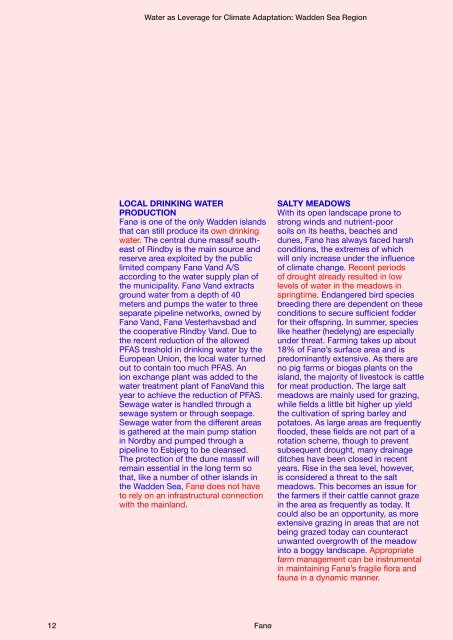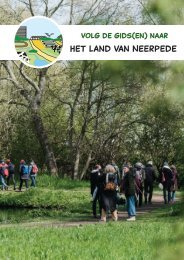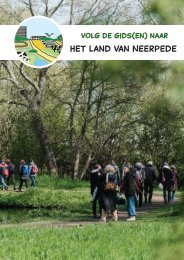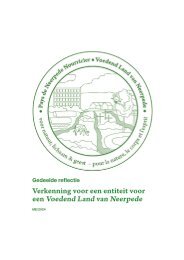Water as Leverage - Wadden Sea Region
- No tags were found...
Create successful ePaper yourself
Turn your PDF publications into a flip-book with our unique Google optimized e-Paper software.
<strong>Water</strong> <strong>as</strong> <strong>Leverage</strong> for Climate Adaptation: <strong>Wadden</strong> <strong>Sea</strong> <strong>Region</strong><br />
LOCAL DRINKING WATER<br />
PRODUCTION<br />
Fanø is one of the only <strong>Wadden</strong> islands<br />
that can still produce its own drinking<br />
water. The central dune m<strong>as</strong>sif southe<strong>as</strong>t<br />
of Rindby is the main source and<br />
reserve area exploited by the public<br />
limited company Fanø Vand A/S<br />
according to the water supply plan of<br />
the municipality. Fanø Vand extracts<br />
ground water from a depth of 40<br />
meters and pumps the water to three<br />
separate pipeline networks, owned by<br />
Fanø Vand, Fanø Vesterhavsbad and<br />
the cooperative Rindby Vand. Due to<br />
the recent reduction of the allowed<br />
PFAS treshold in drinking water by the<br />
European Union, the local water turned<br />
out to contain too much PFAS. An<br />
ion exchange plant w<strong>as</strong> added to the<br />
water treatment plant of FanøVand this<br />
year to achieve the reduction of PFAS.<br />
Sewage water is handled through a<br />
sewage system or through seepage.<br />
Sewage water from the different are<strong>as</strong><br />
is gathered at the main pump station<br />
in Nordby and pumped through a<br />
pipeline to Esbjerg to be cleansed.<br />
The protection of the dune m<strong>as</strong>sif will<br />
remain essential in the long term so<br />
that, like a number of other islands in<br />
the <strong>Wadden</strong> <strong>Sea</strong>, Fanø does not have<br />
to rely on an infr<strong>as</strong>tructural connection<br />
with the mainland.<br />
SALTY MEADOWS<br />
With its open landscape prone to<br />
strong winds and nutrient-poor<br />
soils on its heaths, beaches and<br />
dunes, Fanø h<strong>as</strong> always faced harsh<br />
conditions, the extremes of which<br />
will only incre<strong>as</strong>e under the influence<br />
of climate change. Recent periods<br />
of drought already resulted in low<br />
levels of water in the meadows in<br />
springtime. Endangered bird species<br />
breeding there are dependent on these<br />
conditions to secure sufficient fodder<br />
for their offspring. In summer, species<br />
like heather (hedelyng) are especially<br />
under threat. Farming takes up about<br />
18% of Fanø’s surface area and is<br />
predominantly extensive. As there are<br />
no pig farms or biog<strong>as</strong> plants on the<br />
island, the majority of livestock is cattle<br />
for meat production. The large salt<br />
meadows are mainly used for grazing,<br />
while fields a little bit higher up yield<br />
the cultivation of spring barley and<br />
potatoes. As large are<strong>as</strong> are frequently<br />
flooded, these fields are not part of a<br />
rotation scheme, though to prevent<br />
subsequent drought, many drainage<br />
ditches have been closed in recent<br />
years. Rise in the sea level, however,<br />
is considered a threat to the salt<br />
meadows. This becomes an issue for<br />
the farmers if their cattle cannot graze<br />
in the area <strong>as</strong> frequently <strong>as</strong> today. It<br />
could also be an opportunity, <strong>as</strong> more<br />
extensive grazing in are<strong>as</strong> that are not<br />
being grazed today can counteract<br />
unwanted overgrowth of the meadow<br />
into a boggy landscape. Appropriate<br />
farm management can be instrumental<br />
in maintaining Fanø’s fragile flora and<br />
fauna in a dynamic manner.<br />
12<br />
Fanø


















